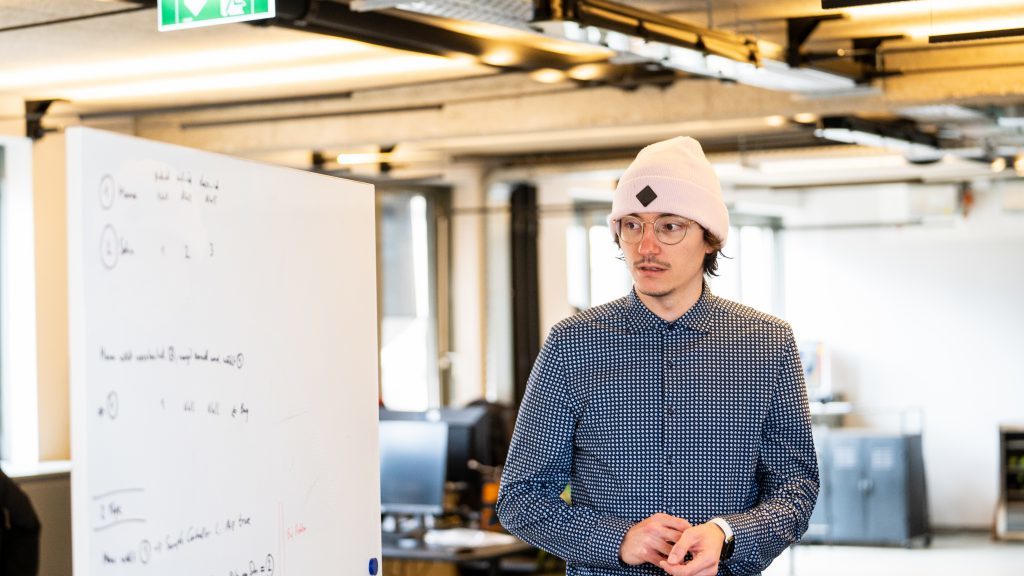Young Leadership
Dotbite started with four students having an idea with a lot of positive impact on other students and has since then developed into a software agency with five young leaders and 15 team members. Has it been challenging sometimes? Oh yeah. But it is a fun ride! And that is why we wanted to talk about young leadership in this blog article.
Heart and soul
Leadership has many definitions – sometimes it’s a set of characteristics that makes a good leader, other times it’s their quality or ability, or the position itself defines someone as a leader. From our point of view, leadership is all of that and much more. When it all started, the four friends, Adrian, Emir, Christoph, and Paul, decided to work together on an idea that would change their life. They have naturally developed into leaders who are much more connected to Dotbite than people brought from outside ever could. This is a massive benefit for all of us, not only because of knowledge sharing from day one but also because Dotbite is not a just company for them; it is the heart and soul of our founders. Now, you probably want to know how exactly that works. We asked our leaders to tell us what leadership means to them.
Something new

Paul, our CTO, has a motto saying, “It is essential that we show interest in learning and do not fear to try something new.” This way of thinking is part of Dotbite’s core concepts and causes all of us to grow alongside the company. Forbes has released an article on surprising reasons younger managers perform best, mentioning continuous improvement, including the will to challenge the status quo, as one of the top reasons. Looking at Dobite, we have established a weekly tech night where people share knowledge. In our team meetings, people share current challenges and continuously implement new methods and tools. We also have open discussions on ideas for future projects within the whole team. In addition, there is a monthly founder’s meeting where our leaders discuss current topics and share new leadership knowledge. Of course, some might say this is just proper team culture, but we think it starts from the top and depends on the active involvement of the leaders themselves.
Authenticity

When we asked what leadership meant for our CEO Emir, he answered: “Leadership means encouraging the people around me to be authentic and to take personal responsibility. It means to inspire them to do things the way they think is right, while at the same time giving them the confidence to do so.” So whether it’s wearing your favorite hoodie, the immediate feedback you get on your work, the conversations about our weekends where someone always has a funny story to tell, or the guys relentlessly roasting each other during lunchtime, you can be you – and authenticity is contagious.
DIY

Adrian’s motto is “feel free,” which is connected to Emir’s statement. Encouragement and trust in each other let us organize our day independently, ask for help when needed, try new things, and use each other’s know-how to tackle challenges. Knowing that each of us has unique skills and knowledge in our field gives lets us work on our goals while making an impact with our decisions. In addition, it frees our leaders from making every decision. Everyone decides the OKRs (Objectives and Key Results) for their area of responsibility individually to achieve the main objectives we decided on as a team. Then, each team is free to work independently on achieving these OKRs while we work together on a bigger goal.
Leading by example

Christoph told us, “I always try to set a good example myself, true to the motto lead by example.” Whether it is being honest, being open to learning something new, or trusting in each other, by setting the tone as leaders, the team can follow their steps. Feedback is thus not a one-way street and is offered regularly in our daily stand-ups or in-depth during the one-to-one reviews twice a year. In these, a team leader and an employee sit down for a couple of hours to discuss development, working together, and their advice for each other. This way, both employees and leaders have the chance to learn and reflect.
New blood

Speaking of personal development, we have already had a promotion of an employee to a leadership position: Lukas, our Head of EdTech. A leadership statistic of 2021 said that “Internal hires for leadership roles are 25% more successful than external hires.” We can absolutely agree here. Lukas has achieved lots as an employee, but he marvels at his new role in a leadership position with a strong team behind him. When we asked him, what leadership meant to him, he said: “Leadership for me is to have empathy for the individuality of every employee, to trust and motivate them every day and to act as a role model.” His statement mirrors everything our founders aim for and shows that leading by example helps others grow as leaders themselves.
Challenges
So, this all sounds like a lot of fun – but what kind of challenges do our young leaders have?
“Keeping the focus on your work while trying to pay close attention to everyone’s challenges” is a difficulty Paul shared with us. Of course, being a leader is a job itself, and having to work on own projects ads additional workload. Lukas mentioned, “I see it as a challenge to fulfill all requests of every employee.” Each person has other needs to work efficiently, which he needs to consider. Christoph told us, “You have to face new challenges every day and make many decisions that you need to stand behind.” Emir and Adrian both said that being able to put your own needs back and focus on what’s is best for the team can be a challenge. They all know, however, that the team is our greatest asset.
Why do we share all this? Because we genuinely think the guys are doing an outstanding job the whole company can be proud of. If your experiences with people in leadership positions are less stellar, we are always hiring 😉